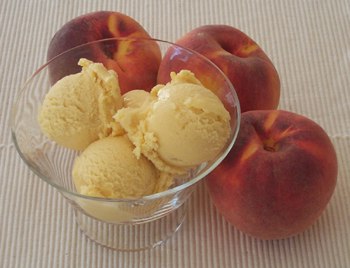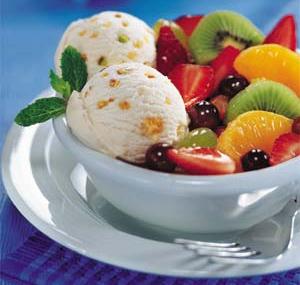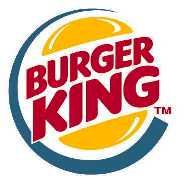|
Traditional Japanese cuisine
Sashimi
 Sashimi is fresh seafood cut into easy-to-eat sizes. Sashimi is dipped into
shoyu (soy sauce) and then eaten, but the flavor can be further enhanced by
properly using condiments such as wasabi , (Japanese horseradish), ginger, and
garlic. Sashimi is fresh seafood cut into easy-to-eat sizes. Sashimi is dipped into
shoyu (soy sauce) and then eaten, but the flavor can be further enhanced by
properly using condiments such as wasabi , (Japanese horseradish), ginger, and
garlic.
Sushi
Nigiri-zushi is hand-molded sushi in which raw fish, some other cooked seafood,
egg roll, or other food is placed on an 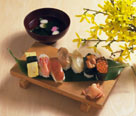 oblong ball of vinegared rice. It is
eaten with a dash of shoyu . Bo-zushi (pressed sushi), which uses marinated fish
instead of raw fish, and chirashi-zushi (“scattered” sushi), a colorful dish in
which sashimi, slices of egg roll, lightly cooked mushrooms, etc. are placed on
a bed of vinegared rice, are also popular sushi dishes. Norimaki-zushi is sushi
rice rolled and wrapped in seaweed (nori ) and with fillings such as natto (fermented
soybeans) or strips of cucumber. oblong ball of vinegared rice. It is
eaten with a dash of shoyu . Bo-zushi (pressed sushi), which uses marinated fish
instead of raw fish, and chirashi-zushi (“scattered” sushi), a colorful dish in
which sashimi, slices of egg roll, lightly cooked mushrooms, etc. are placed on
a bed of vinegared rice, are also popular sushi dishes. Norimaki-zushi is sushi
rice rolled and wrapped in seaweed (nori ) and with fillings such as natto (fermented
soybeans) or strips of cucumber.
Sukiyaki
Suikyaki is hot-pot cooking in which diners pick items from the same
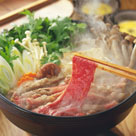 pot.
Thinly-cut slices of beef, onion, shirataki (very low calorie whitish or grayish
vermicelli-like noodles made from one kind of tuber), and broiled tofu are
simmered in a special-use pot and then dipped into a sauce mixture of raw egg
and broth before eating. pot.
Thinly-cut slices of beef, onion, shirataki (very low calorie whitish or grayish
vermicelli-like noodles made from one kind of tuber), and broiled tofu are
simmered in a special-use pot and then dipped into a sauce mixture of raw egg
and broth before eating.
Shabu-shabu
Another kind of hot-pot cooking in which different kinds of meat or 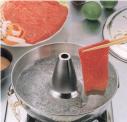 seafood and vegetables are stirred around in boiling water and then dipped into a special
sauce before eating. Typical sauces are a slightly acidic mixture of ponsu (juice
pressed from a citrus fruit) and shoyu , and a sweetish sesame sauce.
Shabu-shabu is usually eaten on cold winter nights, but even in summer there is
a delicious version called hiyashi-shabu , in which the ingredients are chilled
after boiling. seafood and vegetables are stirred around in boiling water and then dipped into a special
sauce before eating. Typical sauces are a slightly acidic mixture of ponsu (juice
pressed from a citrus fruit) and shoyu , and a sweetish sesame sauce.
Shabu-shabu is usually eaten on cold winter nights, but even in summer there is
a delicious version called hiyashi-shabu , in which the ingredients are chilled
after boiling.
Tempura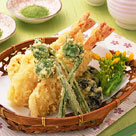
Seafood and vegetables coated with a water-and-flour batter are lightly
fried in
oil and then dipped in a special clear sauce or salt for eating. Another popular
tempura dish is ten-don , in which tempura pieces are served over rice in a bowl
and coated with a shoyu -based sauce.
Soba, Udon, Ramen
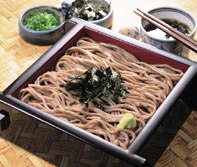 Soba, made from buckwheat flour, udon, from wheat flour, and ramen (Chinese-style
noodles) are popular noodles in Japan. Soba and udon are eaten with a shoyu -based
soup or chilled after cooking and then dipped in a shoyu -based sauce before
eating. There are various soups for ramen such as shoyu -based, miso -based, or
pork-based soups. Chilled ramen dishes are also on many menus. Soba, made from buckwheat flour, udon, from wheat flour, and ramen (Chinese-style
noodles) are popular noodles in Japan. Soba and udon are eaten with a shoyu -based
soup or chilled after cooking and then dipped in a shoyu -based sauce before
eating. There are various soups for ramen such as shoyu -based, miso -based, or
pork-based soups. Chilled ramen dishes are also on many menus.
Unagi (eel)
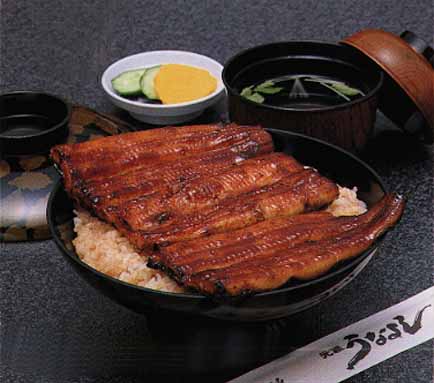
Popular unagi dishes are kabayaki , eels split and broiled with a glaze of a
sweetened shoyu -based sauce, and shirayaki , eel broiled with a sauce. Kabayaki
is served over rice in a bowl or in a jubako , a lacquered rectangular box.
Tonkatsu, Yakitori
Tonkatsu is a pork cutlet coated with flour and bread crumbs, then fried in oil,
and eaten with a special sauce. Yakitori is chicken of all cuts 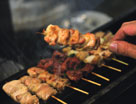 or its internal
organs skewered on a stick, grilled,
and eaten with a sauce or
salt.Shichimi-togarashi (a hot blend of seven types of spices including red
chili flakes, Japanese peppercorns, sesame seeds, etc.) can also be sprinkled on
it. Both tonkatsu and yakitori can be served over rice in a bowl to make the
dishes katsudon and yakitoridon. or its internal
organs skewered on a stick, grilled,
and eaten with a sauce or
salt.Shichimi-togarashi (a hot blend of seven types of spices including red
chili flakes, Japanese peppercorns, sesame seeds, etc.) can also be sprinkled on
it. Both tonkatsu and yakitori can be served over rice in a bowl to make the
dishes katsudon and yakitoridon.
Miso soup
Miso-shiru (soup) is made by bringing dashi (a clear soup stock made from dried
kelp and fish shavings) to boil and then mixing in a very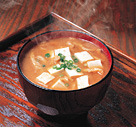 time-honored Japanese
flavoring, miso (a traditional condiment made from fermented soybeans). Miso
soup is an indispensable dish for Japanese meals. There are many types of miso
throughout Japan, and aka-miso (red miso), a darker and more pungent miso from
Aichi, and shiro-miso (white miso), from Kyoto, are particularly well-known. The
specific ingredients put into miso soup vary according to the specialties of the
region and the tastes of the family. time-honored Japanese
flavoring, miso (a traditional condiment made from fermented soybeans). Miso
soup is an indispensable dish for Japanese meals. There are many types of miso
throughout Japan, and aka-miso (red miso), a darker and more pungent miso from
Aichi, and shiro-miso (white miso), from Kyoto, are particularly well-known. The
specific ingredients put into miso soup vary according to the specialties of the
region and the tastes of the family.
Shojin-ryori (vegetarian cooking)
Shojin-ryori was developed by Buddhist priests using soybean tofu, vegetables,
and nuts to create this cuisine, which is especially recommended for vegetarians.
Shojin-ryori restaurants can usually be found in “temple towns” (towns or
districts built around a temple or a shrine), or sometimes temples themselves
serve this cuisine.
Kaiseki-ryori
Kaiseki-ryori is very elegant traditional Japanese cuisine that developed from
the simple dishes served at the tea ceremony. Sashimi, nimono (simmered foods),
yakimono (grilled foods), suimono (clear soup), and then rice and pickled
vegetables are served in a precise order. Seasonal foods are richly used, and
the presentation of the food is always beautiful. A smaller tray or luncheon box
that has a combination of kaiseki foods can also be ordered at a reasonable
price.
|

 Sashimi is fresh seafood cut into easy-to-eat sizes. Sashimi is dipped into
shoyu (soy sauce) and then eaten, but the flavor can be further enhanced by
properly using condiments such as wasabi , (Japanese horseradish), ginger, and
garlic.
Sashimi is fresh seafood cut into easy-to-eat sizes. Sashimi is dipped into
shoyu (soy sauce) and then eaten, but the flavor can be further enhanced by
properly using condiments such as wasabi , (Japanese horseradish), ginger, and
garlic.  oblong ball of vinegared rice. It is
eaten with a dash of shoyu . Bo-zushi (pressed sushi), which uses marinated fish
instead of raw fish, and chirashi-zushi (“scattered” sushi), a colorful dish in
which sashimi, slices of egg roll, lightly cooked mushrooms, etc. are placed on
a bed of vinegared rice, are also popular sushi dishes. Norimaki-zushi is sushi
rice rolled and wrapped in seaweed (nori ) and with fillings such as natto (fermented
soybeans) or strips of cucumber.
oblong ball of vinegared rice. It is
eaten with a dash of shoyu . Bo-zushi (pressed sushi), which uses marinated fish
instead of raw fish, and chirashi-zushi (“scattered” sushi), a colorful dish in
which sashimi, slices of egg roll, lightly cooked mushrooms, etc. are placed on
a bed of vinegared rice, are also popular sushi dishes. Norimaki-zushi is sushi
rice rolled and wrapped in seaweed (nori ) and with fillings such as natto (fermented
soybeans) or strips of cucumber.  pot.
Thinly-cut slices of beef, onion, shirataki (very low calorie whitish or grayish
vermicelli-like noodles made from one kind of tuber), and broiled tofu are
simmered in a special-use pot and then dipped into a sauce mixture of raw egg
and broth before eating.
pot.
Thinly-cut slices of beef, onion, shirataki (very low calorie whitish or grayish
vermicelli-like noodles made from one kind of tuber), and broiled tofu are
simmered in a special-use pot and then dipped into a sauce mixture of raw egg
and broth before eating.  seafood and vegetables are stirred around in boiling water and then dipped into a special
sauce before eating. Typical sauces are a slightly acidic mixture of ponsu (juice
pressed from a citrus fruit) and shoyu , and a sweetish sesame sauce.
Shabu-shabu is usually eaten on cold winter nights, but even in summer there is
a delicious version called hiyashi-shabu , in which the ingredients are chilled
after boiling.
seafood and vegetables are stirred around in boiling water and then dipped into a special
sauce before eating. Typical sauces are a slightly acidic mixture of ponsu (juice
pressed from a citrus fruit) and shoyu , and a sweetish sesame sauce.
Shabu-shabu is usually eaten on cold winter nights, but even in summer there is
a delicious version called hiyashi-shabu , in which the ingredients are chilled
after boiling. 
 Soba, made from buckwheat flour, udon, from wheat flour, and ramen (Chinese-style
noodles) are popular noodles in Japan. Soba and udon are eaten with a shoyu -based
soup or chilled after cooking and then dipped in a shoyu -based sauce before
eating. There are various soups for ramen such as shoyu -based, miso -based, or
pork-based soups. Chilled ramen dishes are also on many menus.
Soba, made from buckwheat flour, udon, from wheat flour, and ramen (Chinese-style
noodles) are popular noodles in Japan. Soba and udon are eaten with a shoyu -based
soup or chilled after cooking and then dipped in a shoyu -based sauce before
eating. There are various soups for ramen such as shoyu -based, miso -based, or
pork-based soups. Chilled ramen dishes are also on many menus.
 or its internal
organs skewered on a stick, grilled,
and eaten with a sauce or
salt.Shichimi-togarashi (a hot blend of seven types of spices including red
chili flakes, Japanese peppercorns, sesame seeds, etc.) can also be sprinkled on
it. Both tonkatsu and yakitori can be served over rice in a bowl to make the
dishes katsudon and yakitoridon.
or its internal
organs skewered on a stick, grilled,
and eaten with a sauce or
salt.Shichimi-togarashi (a hot blend of seven types of spices including red
chili flakes, Japanese peppercorns, sesame seeds, etc.) can also be sprinkled on
it. Both tonkatsu and yakitori can be served over rice in a bowl to make the
dishes katsudon and yakitoridon. time-honored Japanese
flavoring, miso (a traditional condiment made from fermented soybeans). Miso
soup is an indispensable dish for Japanese meals. There are many types of miso
throughout Japan, and aka-miso (red miso), a darker and more pungent miso from
Aichi, and shiro-miso (white miso), from Kyoto, are particularly well-known. The
specific ingredients put into miso soup vary according to the specialties of the
region and the tastes of the family.
time-honored Japanese
flavoring, miso (a traditional condiment made from fermented soybeans). Miso
soup is an indispensable dish for Japanese meals. There are many types of miso
throughout Japan, and aka-miso (red miso), a darker and more pungent miso from
Aichi, and shiro-miso (white miso), from Kyoto, are particularly well-known. The
specific ingredients put into miso soup vary according to the specialties of the
region and the tastes of the family. 